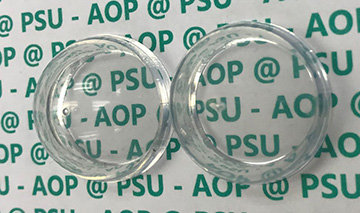
Plastic dome coated with a new antireflection coating (right) and uncoated dome (left). [Image: Giebink Laboratory, Penn State]
Acrylic and polycarbonate lenses appear in all sorts of optical applications, but the inorganic antireflection (AR) coatings that improve the performance of glass lenses are difficult to apply to plastic optical surfaces. Researchers at a U.S. university have developed a method for coating these plastic lenses with a fluoropolymer that adheres well and even makes the surfaces seemingly invisible to a viewer (Nano Lett., doi:10.1021/acs.nanolett.8b03886).
In addition to improving optical components, the AR coatings could enhance the efficiency of solar panels that use plastic lenses to concentrate sunlight. Other possible uses include reducing reflections in security camera domes and virtual-reality gear.
The secret is in the sacrifice
The secret to making this coating, according to Noel “Chris” Giebink and his team at Pennsylvania State University’s electrical engineering department, is to deposit two types of molecules onto the plastic lens surfaces, not just one. While evaporating the amorphous fluoropolymer onto the substrate, the researchers add in a “sacrificial” molecule—a type of organic semiconductor.
During the evaporative deposition, the fluoropolymer chains break up and repolymerize on the substrate around the semiconductor molecules. When the substrate lens surfaces are washed with a solvent such as isopropyl alcohol, the sacrificial molecules dissolve away, leaving behind a fluoropolymer coating that is porous on the nanoscale. The process is similar to one in tissue engineering, when dissolvable particles called porogensare used to make a porous structure for supporting cells.
Performing in the infrared
The resulting AR coating, according to the researchers, has an effective refractive index of 1.08 and reduces the reflectance of acrylic to less than 0.5 percent over a broad wavelength range of impinging light—from 400 nm to 2000 nm, well into the infrared region. That’s a much broader response than the AR coatings used in eyeglasses, which need to reduce reflection only in the visible range.
The new coating is also rugged enough to pass the “Scotch tape test” of applying the sticky tape to the lens and sharply pulling it off. Other tests showed that the material still performed robustly after three months of exposure to outdoor conditions on a rooftop.
